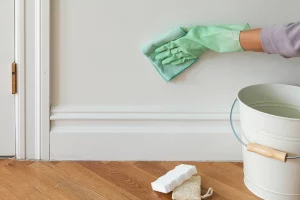
Even though water is a universal ingredient used for cleaning, it may also leave stains. How? Water is not always pure and what is more, some fabrics do not respond well to getting wet. They may lose their shape or suffer discolouration of the fibres. Another common reason for water stains is when the area has stayed wet for a while. That often happens to walls or carpets. Plumbing or roof leaks may cause that. Those types of stains can be cleaned with common household ingredients, however, that depends on the fabric or material that has suffered the staining. If you have any vintage or fragile upholstery or carpets that you need to clean, it is best to contact professionals in order to avoid damage.
In this article, we will discuss the ways in which you can easily get rid of water stains from various materials and areas around the house and how to prevent those unsightly marks from appearing all over your place.
Cleaning water stains from fabrics (curtains, clothes, upholstery, or bedding)
1. Mix a cleaning solution by combining 2 cups of distilled water and ½ cup of white distilled vinegar.
2. Test in an inconspicuous area – Always apply a bit of the cleaning solution to a hidden area of the upholstery or curtain. Let it dry and check for any discolouration before attempting to clean the larger stained area.
3. Dab the stained area – Dip a clean cloth in the solution, wring it until it is damp and dab at the stained area until it is completely wet. Do not rub or scrub the fabric to prevent damage.
4. Absorb the moisture – Stack some paper towels together, place them on the wet area and weigh them down. Check and replace them as they absorb moisture from the fabric.
5. Dry – When they are no longer absorbing any moisture, dry the area by using a handheld hair dryer. Make sure you don’t hold it too close to the fabric in order to prevent any damage.
Cleaning water stains from walls
Removing water stains from walls can be a bit trickier. However, with the right approach and suitable cleaning tools, you will be able to completely remove them. Before you begin the cleaning process, make sure you fix any roof leaks or other sources of water damage. Otherwise, you will have to clean the same mess over and over again.
1. Mix a cleaning solution – Mix a quart of warm water and one teaspoon of dishwashing liquid. Fill a second bucket with plain water (you will use it to rinse the area after cleaning).
2. Prepare the area – Place a plastic sheet on the floor to catch any drips. Use a ladder or a stool if the stain is higher on the wall. Make sure the cloth or sponge you are using is not too wet and dripping. Work slowly and be patient.
3. Start cleaning – Dip a sponge in the cleaning solution and wring it until it is just damp. Start at the top and scrub gently in small circles. Rinse the sponge frequently. When you are done cleaning the area, dip a clean sponge in the plain water, squeeze out the excess moisture and start rinsing the freshly cleaned area to get rid of any soapy residue.
4. Dry the area – Use a soft, lint-free cloth to dab at the cleaned area. Remove any moisture and let the area air dry for a few hours. If you can still see the water stain, repeat the steps above.
5. For stubborn stains – If the water still has some water or mildew stains, you may need to use chlorine bleach in order to get rid of them. Mix 1 cup of chlorine bleach and 3 cups of water (always wear rubber gloves for protection). Open the window to improve ventilation in the room, dip a cloth in the solution and dab it onto the stained area. Let the solution stay on the wall for about 30 minutes, then use a clean dry cloth to dab away the excess moisture. Let the wall air dry (this may take 4-5 hours).
Extra tips on how to prevent water stains:
• Repair any roof or plumbing leaks.
• Check windows and doors and make sure they are weatherproof and able to prevent moisture from entering.
• Use towels to absorb moisture and water puddles from your shoes. In winter, place a plastic tray or some rags on the area where your wet shoes stay. That will save your floors from water stains.
• Do not place plants directly on the floors.
• Use fans in your kitchen and bathroom to prevent condensation and excess moisture from staining your walls.
• Keep your windows open whenever possible. If you have some moisture in the house, good ventilation will prevent it from settling in and staining your walls.